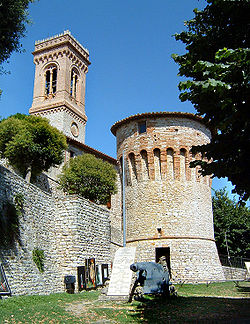Corciano
| Corciano | |
|---|---|
| Comune | |
| Comune di Corciano | |
 |
|
| Location of Corciano in Italy | |
| Coordinates: 43°08′N 12°17′E / 43.133°N 12.283°ECoordinates: 43°08′N 12°17′E / 43.133°N 12.283°E | |
| Country | Italy |
| Region | Umbria |
| Province / Metropolitan city | Perugia |
| Frazioni | Chiugiana-La Commenda, Comparati, Mantignana, Mestigliano, Migiana, Pantanella, San Mariano, Solomeo, Strozzacapponi, Borghetto, Buchignano, Corciano Vecchio, Fonte Viscola, Fornaci Rinaldi, Il Rigo, La Trinità, Le Cupe, Mandrello-Palazzone, Mezzopiano, Palazza, Paletta, San Carlo, San Pietro, Tegolaio I, Tegolaio II, Terrioli, Valliano, Valpinza |
| Government | |
| • Mayor | Nadia Ginetti |
| Area | |
| • Total | 63.69 km2 (24.59 sq mi) |
| Elevation | 408 m (1,339 ft) |
| Population (2007) | |
| • Total | 18,493 |
| • Density | 290/km2 (750/sq mi) |
| Demonym(s) | Corcianesi |
| Time zone | CET (UTC+1) |
| • Summer (DST) | CEST (UTC+2) |
| Postal code | 06073 |
| Dialing code | 075 |
| Patron saint | Saint Michael |
| Saint day | May 8 |
| Website | Official website |
Corciano is a comune (municipality) in the Province of Perugia in the Italian region Umbria, located about 8 km west of Perugia. As of 31 December 2004, it had a population of 17,008 and an area of 63.7 km². Corciano borders the comuni of Magione and Perugia.
The earliest traces of human presence (some fragments of flint tools on blades and fragments of vases turned into dough) date back to Neolithic times. The discovery of two cinerari vessels (preserved in the Museum of the Palazzo Municipale) indicate the presence of humans in the period between the ninth and eighth centuries BC Between the third and first centuries BC formed several settlements (usually small) dedicated mainly to agricultural and artisanal.
The immediate neighborhood was populated by Etruscans, whose presence was dramatically signaled by the discovery in 1812 of bronze panels from a parade chariot, at Castel San Mariano di Corciano. Under Roman rule it became a district of Roman agricultural villas.
A mythical founder Coragino, companion of Ulysses, is a medieval invention recounted in the fourteenth-century Conto di Corciano e di Perugia. With the unsettled conditions of Late Antiquity, the inhabitants withdrew to the defensible hilltop site that controlled the valley that communicated between Lake Trasimeno and the upper Tiber valley. Its curving concentric street system is testimony to the three encircling walls that protected the community. Like virtually all early walled villages, the Corcianesi were under the control of the bishop, in this case the bishop of Perugia, whose rights to the castrum de Corciano were confirmed by Pope Innocent II in 1136; Corciano appears in a list of castelli belonging to Perugia, 1258. A visit by Francis of Assisi is commemorated, after his canonisation, in a church dedicated to him, which retains traces of its fourteenth and fifteenth-century frescoes. The tower of the comune, built in the thirteenth century, rises from the highest point. The triple walls and strategic site of Corciano made it a desirable stronghold in the constant warfare of the fourteenth and fifteenth centuries: in 1364 the little town was sacked by the Compania Bianca in the service of Cardinal Albornoz; in 1416 the condottiero Braccio Fortebraccio of Montone laid siege to Corciano, which resisted successfully but capitulated to him when he returned for a second attempt.
...
Wikipedia

